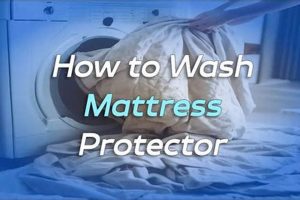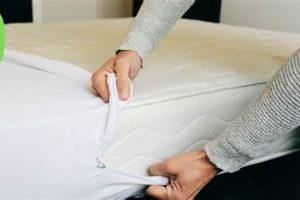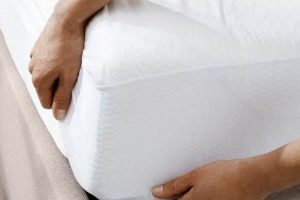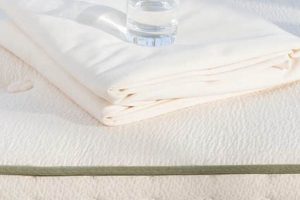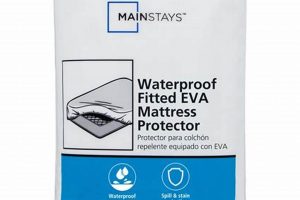A covering designed to enhance comfort differs significantly from one intended primarily for safeguarding the underlying sleep surface. The former typically features a layer of padding, adding softness and potentially altering the feel of the mattress. The latter, conversely, emphasizes defense against spills, stains, and allergens, often employing waterproof or resistant materials. As an example, one might add a plush layer of fiberfill to soften a firm mattress, whereas the objective of the second option is to shield the sleep surface from liquids or bed bugs.
Maintaining a clean and hygienic sleep environment contributes significantly to overall well-being. Extending the lifespan of the mattress represents a cost-effective approach to furnishing a bedroom. Historically, concerns about hygiene and mattress longevity have driven the development and adoption of various coverings. The introduction of modern materials has further refined the protective capabilities of these items, offering enhanced barriers against common sleep-related issues.
The following sections will examine the specific attributes of each type, highlighting their construction, materials, intended uses, and ultimately, the key distinctions that inform consumer choice. This detailed analysis provides clarity for selecting the appropriate bedding accessory to meet individual needs and preferences.
Guidance on Mattress Underlay Selection
Selecting the appropriate mattress underlay requires careful consideration of individual needs and priorities. Understanding the distinctions between protective and comfort-enhancing options is paramount for informed decision-making.
Tip 1: Prioritize Protection Against Spills and Allergens. If safeguarding against liquids, dust mites, and other allergens is the primary concern, a waterproof model with hypoallergenic properties represents the optimal choice. Look for tightly woven fabrics and impermeable membranes.
Tip 2: Evaluate Material Composition. Different materials offer varying degrees of comfort, protection, and durability. Cotton, memory foam, and down alternatives each possess unique characteristics. Research and compare material properties before committing to a purchase.
Tip 3: Consider Mattress Depth. Ensure the selected item accommodates the mattress’s thickness. Many protectors and pads feature elasticized sides or deep pockets to accommodate thicker mattresses. Incorrect sizing can compromise both comfort and protective capabilities.
Tip 4: Assess the Need for Added Comfort. If seeking to alter the feel of the sleep surface, a model with substantial padding, such as memory foam or down, may be appropriate. Determine the desired level of firmness or softness before selecting a specific pad type.
Tip 5: Review Care Instructions. Regular cleaning is essential for maintaining hygiene and prolonging the lifespan of mattress underlays. Carefully review the manufacturer’s care instructions before purchase to ensure compatibility with established cleaning routines.
Tip 6: Confirm Breathability. Materials like cotton and some advanced synthetics promote airflow, which can help regulate temperature during sleep. Breathable options contribute to a more comfortable and less humid sleep environment.
Tip 7: Evaluate for Noise. Some materials, particularly those with waterproof layers, can generate noise with movement. Consider this factor if noise sensitivity is a concern.
The careful application of these guidelines will aid in the selection of an underlay that meets individual comfort, protection, and maintenance requirements. A well-chosen product contributes to a cleaner, more comfortable, and longer-lasting sleep environment.
The subsequent section will delve further into specific features and benefits, further informing the consumer about optimal mattress underlay selection.
1. Primary function
The primary function serves as the fundamental differentiator between a mattress pad and a protector. This underlying purpose dictates design, material selection, and ultimately, the user experience. A mattress pad is primarily intended to enhance the sleeper’s comfort. It achieves this by adding a layer of cushioning or modifying the feel of the existing mattress. In contrast, a mattress protector’s foremost aim is to safeguard the mattress itself from damage, such as spills, stains, allergens, and bed bugs. The disparate objectives necessitate varying constructions and material choices.
The emphasis on comfort in mattress pads leads to the incorporation of materials like memory foam, down alternatives, or thick cotton fillings. These materials contribute to a softer or more supportive sleep surface. For example, individuals with firm mattresses may choose a plush mattress pad to alleviate pressure points and improve sleep quality. Conversely, the focus on protection in protectors necessitates waterproof or water-resistant materials such as polyurethane or specialized fabrics with tightly woven structures. The construction often includes a thin, impermeable layer designed to prevent liquids from penetrating the mattress. This difference extends to thickness; protectors are typically thinner to minimize alterations to the mattress’s feel, whereas pads can be significantly thicker to maximize comfort enhancement.
In summary, the distinct primary functions drive the essential distinctions between mattress pads and protectors. Understanding this fundamental difference allows consumers to make informed decisions based on their individual needs. If the primary concern is enhancing sleep surface comfort, a mattress pad is the appropriate choice. If protecting the mattress from damage is the main objective, a mattress protector is the more suitable option. Recognizing this core distinction simplifies the selection process and ensures that the chosen product effectively addresses the user’s priorities.
2. Material Composition
Material composition plays a crucial role in differentiating a mattress pad from a mattress protector. The intended function of each product dictates the materials employed, resulting in significant variations in performance and feel. The choice of materials directly influences factors such as comfort, breathability, waterproofness, and durability, which are key determinants in selecting the appropriate bedding accessory. For example, a mattress pad designed for comfort enhancement commonly incorporates materials such as memory foam, down alternatives (e.g., polyester fiberfill), or natural fibers like cotton or wool. These materials provide cushioning, support, and can alter the temperature regulation properties of the sleep surface. The inherent properties of these materials directly contribute to the pad’s ability to modify the feel of the mattress, thereby increasing comfort.
In contrast, a mattress protector prioritizes barrier properties and often employs materials such as polyurethane laminates or tightly woven synthetic fabrics. These materials offer waterproof or water-resistant qualities, preventing liquids from penetrating the mattress and causing damage. Furthermore, many protectors utilize hypoallergenic materials to create a barrier against dust mites and other allergens, contributing to a healthier sleep environment. The selection of these materials directly impacts the protector’s ability to safeguard the mattress from stains, spills, and allergens. For instance, a protector made with a polyurethane laminate will effectively block liquids, while one constructed from a tightly woven microfiber fabric may offer enhanced breathability while still providing a degree of water resistance.
In conclusion, the material composition constitutes a fundamental aspect of the difference between a mattress pad and a protector. Understanding the properties and intended uses of various materials enables consumers to make informed choices tailored to their specific needs. A clear understanding of the materials used in each type of product allows for optimal selection based on priorities, whether focused on enhancing comfort or providing comprehensive mattress protection.
3. Comfort enhancement
The facet of comfort enhancement serves as a significant differentiating factor when considering the dissimilarities between a mattress pad and a mattress protector. While both items overlay the mattress surface, their contribution to sleep comfort varies considerably, influencing consumer choices and bedding configurations.
- Padding and Loft
A primary means of enhancing comfort involves increasing the padding and loft of the sleep surface. Mattress pads often incorporate substantial layers of materials such as memory foam, down alternatives, or natural fibers. This added thickness alters the feel of the mattress, potentially softening a firm surface or providing additional support. For instance, a pad with several inches of memory foam can significantly contour to the sleeper’s body, relieving pressure points and improving spinal alignment.
- Material Properties
The specific materials used in construction also contribute significantly to comfort. Materials like wool offer temperature regulation, wicking away moisture and keeping the sleeper warm in winter and cool in summer. In contrast, synthetic materials like polyester fiberfill may offer a softer, more plush feel at a lower cost. The choice of material directly impacts the overall sleep experience and should align with individual preferences and needs. For example, individuals with allergies may prefer hypoallergenic materials, while those seeking maximum cushioning may opt for memory foam.
- Surface Texture
The surface texture of the pad can influence comfort by affecting how the sleeper interacts with the mattress. A smooth, quilted surface can reduce friction and promote ease of movement during sleep. Alternatively, a textured surface may provide a subtle massage effect or improve air circulation. The texture should be carefully considered, especially for individuals with sensitive skin or specific tactile preferences. For example, a pad with a raised pattern may provide better airflow, preventing overheating and promoting a more comfortable sleep environment.
- Impact on Support
While primarily focused on comfort, a mattress pad can also indirectly affect support. A thicker pad may distribute weight more evenly across the mattress surface, reducing pressure on specific areas of the body. This can be particularly beneficial for individuals with back pain or other musculoskeletal conditions. The level of support provided by the pad should be considered in relation to the underlying mattress and the sleeper’s individual needs. For instance, a pad with zoned support can provide targeted cushioning to different areas of the body, improving overall comfort and spinal alignment.
In contrast to the comfort-centric design of mattress pads, protectors are typically thinner and less focused on altering the feel of the mattress. Their primary function of safeguarding against spills and allergens often necessitates materials that prioritize barrier properties over enhanced comfort. This fundamental difference in design and intent underscores the distinct roles of mattress pads and protectors in the sleep environment, guiding consumers toward the appropriate choice based on their individual priorities.
4. Water resistance
Water resistance constitutes a critical point of divergence between mattress pads and mattress protectors. The degree to which each item repels or withstands liquid penetration significantly influences its primary function and suitability for specific user needs. Protectors are engineered with a deliberate focus on water resistance, often incorporating impermeable layers or specialized fabric treatments to prevent liquids from reaching the mattress core. Mattress pads, while potentially offering some level of liquid absorption, generally lack the robust barrier properties inherent in protectors. This distinction arises from the differing priorities of each product: protection versus comfort enhancement. The presence or absence of effective water resistance directly impacts the longevity and hygiene of the underlying mattress.
A real-life example illustrates this point: a child’s bedwetting incident. A mattress equipped with a dedicated protector featuring a waterproof membrane would remain dry and stain-free. Conversely, a mattress covered solely by a pad lacking significant water resistance would likely absorb the liquid, leading to potential staining, odor, and the creation of a breeding ground for mold and bacteria. Similarly, accidental spills of beverages or other liquids can permanently damage a mattress if adequate water resistance is not present. The integration of water-resistant technologies into mattress protectors directly addresses these scenarios, extending the lifespan of the mattress and promoting a healthier sleep environment.
In summary, the presence of substantial water resistance is a defining characteristic of mattress protectors, setting them apart from mattress pads. This feature safeguards the mattress against liquid damage, contributing to improved hygiene and extended mattress life. Consumers should carefully consider the water resistance capabilities of each product when making a selection, particularly if concerns about spills, incontinence, or other sources of liquid exposure exist. The informed understanding of this difference facilitates the selection of the appropriate bedding accessory to meet specific needs and priorities.
5. Thickness/Profile
Thickness or profile serves as a readily discernible physical attribute that distinguishes between mattress pads and protectors. This dimension significantly influences both the perceived comfort and the functional characteristics of each type of bedding accessory. The thickness directly affects the degree to which each item alters the feel of the mattress and its capacity to provide either enhanced cushioning or effective protection.
- Impact on Comfort Alteration
Mattress pads, generally thicker, are designed to modify the comfort of the sleep surface. Increased thickness allows for the incorporation of substantial cushioning materials, such as memory foam or fiberfill. The resulting higher profile delivers a noticeable change in the mattress’s feel, softening a firm surface or adding a layer of plushness. This contrasts sharply with mattress protectors, which typically maintain a minimal thickness to avoid significantly altering the original feel of the mattress. For instance, an individual seeking a softer sleep experience would opt for a thicker mattress pad, while someone prioritizing the existing mattress feel alongside protection would choose a thinner protector.
- Protective Capability Trade-offs
While greater thickness can enhance comfort, it also introduces potential trade-offs in terms of protective capabilities. Extremely thick pads, while plush, may not offer the same level of waterproof or allergen-resistant protection as thinner, specialized protectors. The materials best suited for comfort and those optimized for protection often differ, leading to a compromise in thicker pads. For example, a thick down-filled pad may provide exceptional comfort but lack any significant resistance to liquids, rendering it unsuitable for individuals with concerns about spills or incontinence.
- Fit and Compatibility Considerations
The thickness of a mattress pad or protector also affects its compatibility with fitted sheets and the overall aesthetics of the bed. Thicker pads may require deeper-pocketed sheets to ensure a secure fit and prevent slippage. The added height can also alter the appearance of the bed, potentially impacting the overall design of the bedroom. Conversely, thinner protectors are less likely to affect sheet fit or alter the bed’s visual profile. Therefore, the thickness must be considered in relation to existing bedding and aesthetic preferences.
- Heat Retention Properties
Thickness affects heat retention during sleep. A thicker pad, particularly one made from dense materials like memory foam, can trap more heat than a thinner protector or a pad made from breathable materials. This can be advantageous for individuals who tend to feel cold during the night but can lead to overheating for others. Choosing a thickness and material composition that complements individual temperature preferences is therefore crucial for ensuring a comfortable sleep environment. For example, a thin protector made from breathable cotton is less likely to trap heat than a thick memory foam pad.
In summary, thickness or profile is a defining characteristic in differentiating between mattress pads and protectors. It influences comfort alteration, protective capabilities, fit, and heat retention properties. Considering these factors allows consumers to make informed decisions that align with their specific needs and preferences, ensuring a comfortable and protected sleep surface. The balance between thickness and other functional attributes ultimately determines the suitability of each item for individual use cases.
Frequently Asked Questions
The following section addresses common inquiries regarding mattress pads and protectors. It aims to provide clarity on their differences, uses, and selection criteria.
Question 1: What is the primary distinction between a mattress pad and a mattress protector?
The primary distinction lies in their intended purpose. A mattress pad enhances sleep comfort through added cushioning, while a mattress protector safeguards the mattress against spills, stains, and allergens.
Question 2: Does a mattress protector affect the comfort of the mattress?
A mattress protector should minimally affect the comfort of the mattress. High-quality protectors are designed to be thin and unobtrusive, preserving the original feel of the sleep surface.
Question 3: Are all mattress protectors waterproof?
Not all mattress protectors are waterproof. Some protectors offer water resistance, while others provide complete impermeability. The choice depends on the level of protection required.
Question 4: Can a mattress pad replace a mattress protector?
A mattress pad cannot replace a mattress protector. While a pad may offer some degree of liquid absorption, it lacks the dedicated barrier properties necessary to effectively safeguard the mattress from spills and stains.
Question 5: How often should a mattress protector be washed?
A mattress protector should be washed every one to two months, or more frequently if spills occur. Adhering to the manufacturer’s care instructions is essential for maintaining its protective properties.
Question 6: Are there specific materials to avoid when choosing a mattress protector?
Individuals with allergies should avoid protectors containing known allergens, such as latex. Breathable materials like cotton or Tencel are generally preferable to minimize heat retention and promote airflow.
In summary, while both enhance the sleep environment, the mattress pad prioritizes comfort, whereas the protector prioritizes safeguarding the mattress from various potential damages.
The subsequent section will offer guidance on proper maintenance and care for both mattress pads and protectors.
Difference Between Mattress Pad and Protector
This analysis clarifies the essential distinctions inherent to the difference between mattress pad and protector. These items, while both residing atop the mattress, serve fundamentally different purposes. A mattress pad primarily augments comfort, modifying the sleep surface through added cushioning or altered material properties. Conversely, a mattress protector prioritizes safeguarding the underlying mattress from spills, stains, allergens, and other potential sources of damage. The divergence extends to material composition, thickness, and ultimately, the impact on the overall sleep experience. Understanding these variations enables informed purchasing decisions, ensuring the selection aligns with specific needs and priorities.
The informed selection and diligent maintenance of appropriate bedding accessories are vital components of a healthy sleep environment. Whether prioritizing enhanced comfort or robust protection, a clear understanding of the difference between mattress pad and protector empowers consumers to optimize their sleep experience and extend the lifespan of their mattress investment. Careful consideration of individual requirements and the distinct attributes of each product type remains paramount for achieving optimal sleep hygiene and long-term mattress preservation.



